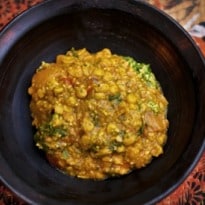It was one of those late-summer days of parched soil, piercing skies and ugly light that makes you squint. The garden was on its knees praying for rain. I am using up the basil that has been living in a pot on the kitchen steps. There are only so many times a tender plant can withstand the yo-yo existence of extreme pampering and utter neglect. It is also time to use the coriander before it goes to seed.
The stems of fine herbs - dill, basil and especially coriander - can hold almost as much flavour as their leaves and fronds. Any of these fragile, soft-stemmed herbs can be processed to a paste for pesto or a herb or spice mix. Not so parsley, thyme or oregano whose tough stems are better in the stock pot, or rosemary - which would be rather like chewing your way through a gorse bush.
I am making a coriander paste - fresh, lively and green as a spring lawn - by processing the leaves and thinnest stems with toasted cashews, basil stems and leaves and a generous splash of lime juice. I could add the coriander roots, too, scrubbed until they are almost white and trimmed of their pesky hair-like tails.
The brilliant paste will keep for a day or two in the fridge, its surface covered with a little olive or groundnut oil, but it's brighter tasting when used as soon as it is made. You could make the paste by hand, too, if your wrists are up to it, pounding the nuts and leaves in a pestle and mortar. A food processor does the job in seconds.
Several heaped spoonfuls of the paste found their way into a straightforward lamb and coconut milk dish in my kitchen this week. More still ended up in a bowl of yellow lentil dal, making it feel both luxurious and vibrant. We couldn't stop eating it.
Herb pastes lift everything from a laksa to a stir fry, but are best added at the last moment to preserve their freshness. Unlike a spice paste, they don't need cooking first, and can be stirred into a lamb korma, a Thai-style chicken soup or a noodle dish just before serving. Mine contains cashews, so I toast those first, just to lend a subtle nutty quality to the paste that I won't get from untoasted nuts.
I could have added my emerald lotion to rice noodles curled up in a coconut and lemongrass-scented laksa, or maybe I could have used a spoon of it spread over lamb cutlets after browning, constantly spooning bubbling oil and butter over them as they cook. But lamb and coconut casserole it was, and later, the dish of green herb-scented dal. These were recipes to revive the spirits.
Coriander lambA mild and creamy lamb casserole given a heady green freshness with a coriander spice paste. Aromatic rather than hot.
Serves 3
onion 1, large
garlic 3 or 4 cloves
olive or groundnut oil
lamb 500g, cubed
coconut milk 500g
For the spice paste:
cashews 80g
coriander 50g
basil 50g
lime juice 5 tbsp (2 limes)
Peel and roughly chop the onion and garlic. Pour two tablespoons of oil into a deep, heavy-based pan, add the onions and garlic then let them cook over a moderate to high heat for 15 minutes or so, until soft and a pale honey tone.
While the onions are cooking, make the spice paste. Put the cashews in a dry, shallow pan and toast until golden. Tip them into the bowl of a food processor, add the coriander leaves and stalks, the basil and the lime juice and process to a rough paste, then set aside.
Remove the onions and garlic from the pan and set aside, return the pan to the heat, add a further tablespoon of oil, then add some of the meat, without crowding the pan, and brown lightly and evenly on all sides. Remove the pieces of lamb as they brown and add them to the onions. Continue with the remaining lamb.
When the last of the meat is browned, add the coconut milk and let it heat through, scraping at any tasty, crusty bits on the surface of the pan and stirring them in to the coconut milk. Return all the meat and onions to the pan, then leave to simmer for a good 10 minutes, seasoning with salt and pepper.
Stir in 3 heaped tablespoons of the spice mix and continue to simmer, gently, for a further 10 minutes. Serve with warm flatbread or rice as you wish.
Split peas with corianderThe warmth of dal, but with the freshness of green herbs. A good one with rice, or as an accompaniment.
Serves 4, generously
yellow split peas 250g
onion 1, medium sized
garlic 4 cloves
groundnut or vegetable oil 2 tbsp
turmeric 1 tsp
paprika 1 tsp
tomatoes 500g
spice paste (see above)5 heaped tbsp
coriander leaves a handful
Rinse the split peas then cook them in deep, unsalted boiling water for about 30 minutes until they are soft and tender.
While the split peas cook, peel and roughly chop the onion and peel and finely slice the garlic. Warm a couple of tablespoons of oil in a medium-sized saucepan then add the onion and garlic and cook over a moderate heat until deep gold and translucent.
Stir the ground turmeric and paprika into the onions, then roughly chop the tomatoes and stir them in. Let the mixture cook over a low to moderate heat for about 15 minutes then stir in the cooked split peas and 5 heaped tablespoons of the coriander spice paste (above).
Green lights: mild and creamy coriander lamb. Photograph: Jonathan Lovekin for the Observer













